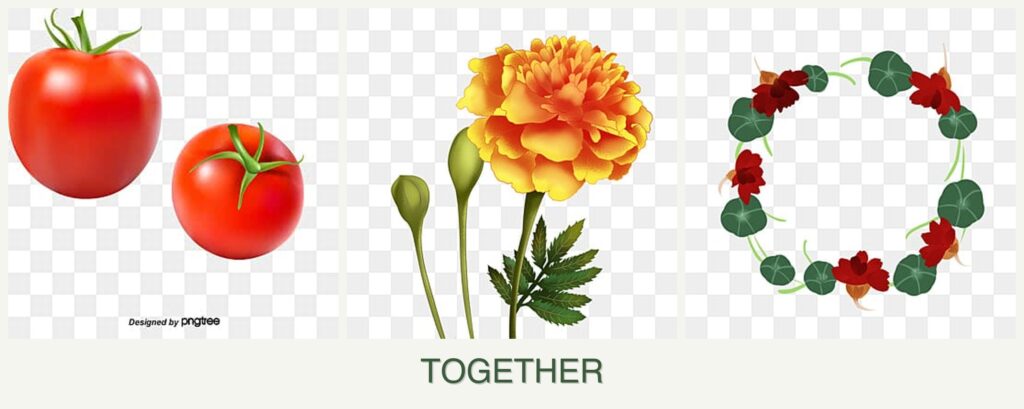
Can you plant tomatoes, marigolds and nasturtiums together?
Can You Plant Tomatoes, Marigolds, and Nasturtiums Together?
Companion planting is a beloved strategy among gardeners, offering natural solutions to common gardening challenges. Tomatoes, marigolds, and nasturtiums are popular choices for those looking to maximize their garden’s health and productivity. In this article, you’ll discover whether these plants can thrive together and learn practical tips for successful companion planting.
Compatibility Analysis
Yes, you can plant tomatoes, marigolds, and nasturtiums together, and they often complement each other well. These plants are compatible due to their mutually beneficial characteristics. Tomatoes thrive in full sun and require well-drained soil, conditions that marigolds and nasturtiums also enjoy.
Marigolds are known for their ability to repel nematodes and other pests, which can benefit tomatoes. Nasturtiums act as a trap crop, attracting aphids away from tomatoes. Their sprawling growth habit can also provide ground cover, reducing weed competition.
Key factors for their compatibility include similar growth requirements and natural pest control properties. However, attention to spacing is crucial to ensure each plant has enough room to grow without competing for nutrients.
Growing Requirements Comparison Table
| Plant | Sunlight Needs | Water Requirements | Soil pH | Soil Type | Hardiness Zones | Spacing | Growth Habit |
|---|---|---|---|---|---|---|---|
| Tomatoes | Full sun | Moderate | 6.0-6.8 | Well-drained | 3-10 | 18-24 inches | Upright, 3-10 ft |
| Marigolds | Full sun | Moderate | 6.0-7.5 | Well-drained | 2-11 | 8-10 inches | Bushy, 6-24 inches |
| Nasturtiums | Full sun | Low to moderate | 6.1-7.8 | Well-drained | 9-11 | 10-12 inches | Trailing/Spreading |
Benefits of Planting Together
- Pest Repellent Properties: Marigolds deter nematodes, while nasturtiums attract aphids away from tomatoes.
- Improved Growth: The natural pest control provided by marigolds and nasturtiums can lead to healthier tomato plants.
- Space Efficiency: Nasturtiums can cover bare soil, reducing weeds and conserving moisture.
- Soil Health Benefits: Marigolds contribute to soil health by suppressing harmful nematodes.
- Pollinator Attraction: Nasturtiums attract pollinators, which can benefit all plants in the garden.
Potential Challenges
- Competition for Resources: Ensure adequate spacing to prevent competition for sunlight and nutrients.
- Different Watering Needs: Nasturtiums require less water than tomatoes, so careful monitoring is needed.
- Disease Susceptibility: Overcrowding can lead to increased humidity and disease risk.
- Harvesting Considerations: The sprawling nature of nasturtiums can make accessing tomatoes more challenging.
Practical Solutions
- Use mulch to retain moisture and reduce watering needs.
- Monitor plant health regularly to catch any signs of disease early.
- Consider vertical supports for tomatoes to maximize space and access.
Planting Tips & Best Practices
- Optimal Spacing: Ensure at least 18-24 inches between tomatoes and 8-12 inches between marigolds and nasturtiums.
- Timing: Plant after the last frost when temperatures consistently stay above 60°F.
- Container vs. Garden Bed: Containers can be used for smaller spaces, but ensure adequate drainage and space.
- Soil Preparation: Enrich soil with compost and ensure good drainage to support healthy growth.
- Additional Companions: Basil and chives also pair well with tomatoes, enhancing flavor and deterring pests.
FAQ Section
-
Can you plant marigolds and tomatoes in the same pot?
- Yes, but ensure the pot is large enough to accommodate both plants’ root systems.
-
How far apart should tomatoes and nasturtiums be planted?
- Space tomatoes 18-24 inches apart and nasturtiums 10-12 inches away.
-
Do tomatoes and marigolds need the same amount of water?
- Both need moderate watering, but monitor soil moisture to avoid overwatering.
-
What should not be planted with tomatoes?
- Avoid planting tomatoes with brassicas (cabbage family) or fennel, which can inhibit growth.
-
Will marigolds affect the taste of tomatoes?
- No, marigolds will not affect the taste of tomatoes.
-
When is the best time to plant these plants together?
- Plant together in spring after the last frost when temperatures are warm enough for tomatoes.
Companion planting tomatoes, marigolds, and nasturtiums can enhance your garden’s productivity and health. By understanding their compatibility and addressing potential challenges, you can create a thriving garden ecosystem.



Leave a Reply